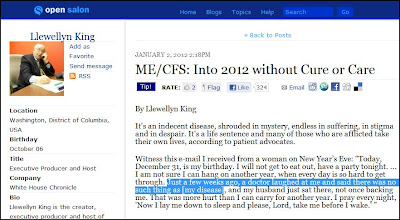It's an indecent disease, shrouded in mystery, endless in suffering, in stigma and in despair. It's a life sentence and many of those who are afflicted take their own lives, according to patient advocates.
Witness this e-mail I received from a woman on New Year’s Eve: “Today, December 31, is my birthday. I will not get to eat out, have a party tonight. ... I am not sure I can hang on another year, when every day is so hard to get through. Just a few weeks ago, a doctor laughed at me and said there was no such thing as [my disease], and my husband just sat there, not once backing me. That was more hurt than I can carry for another year. I pray every night, 'Now I lay me down to sleep and please, Lord, take me before I wake.' ”
This scourge, this foul and stealthy confiscation of life, is so little understood that there's even confusion about its name.
In the United States, the disease is known as Chronic Fatigue Syndrome (CFS): a bland and trivializing nom de plume bestowed on the disease by the Centers for Disease Control in Atlanta. Elsewhere in the world, it's known as myalgic encephalomyelitis (ME). American patients tend to use both names and the acronym ME/CFS.
I've been writing about ME/CFS for three years. But in more than 50 years of journalism, I've never had so much reader response. So many cries from the heart. So much gratitude for doing so little.
The disease is socially ecumenical and afflicts an estimated 1 million people in the United States and 17 million worldwide. I hear from a great cross section of the ME/CFS community who have access to a computer and are well enough to use it.
There are many sufferers who aren't well enough to e-mail; they're severely debilitated and bedridden for months and years.
There are many sufferers who aren't well enough to e-mail; they're severely debilitated and bedridden for months and years.
Deborah Waroff, a colleague of mine from the 1970s, who's been sick for more than two decades, describes a period of total disability she suffered in 2003 and 2004, when she lay on her apartment couch too sick even to watch television, as “lying in your own coffin.”
There is no known route to infection, no diagnoses and no cure. Research has been scattered and funded grudgingly at such low levels that Dr. Fred Volinsky of Boston has calculated annual federal funding for ME/CFS at only $1.25 per patient compared to $400 for multiple sclerosis.
Last year was especially sad because many patients and some researchers had pinned their hopes on a retrovirus called XMRV. Most of the work on this line was done at the Whittemore Peterson Institute in Reno, Nev., a private research facility founded by the Whittemore family. It now appears that promising conclusions were the result of laboratory contamination, and a paper in Science magazine had to be withdrawn. Worse, there's an ugly dispute between the institute and its former chief research scientist Judy Mikovits. Because there's low-level contagion in families and cluster outbreaks of ME/CFS, the idea that there's a virus at work can't be discredited entirely.
There are parallels as well as dissimilarities to the early days of the AIDS. For AIDS, the stigma was sexual; for ME/CFS, the stigma is sloth.
As doctors have no diagnostic procedure for ME/CFS, they dismiss it as imaginary, psychosomatic or sloth. Families believe the disease is sloth: Sons have written to me because their fathers disowned them, believing that they are just layabouts.
Some sufferers are homeless, according to Dr. Leonard Jason of DePaul University, abandoned to life on the streets. He tells of one unfortunate living in a car.
Hospital emergency rooms have no tools, no knowledge. In the frenzy of the just-in-time nature of emergency room medicine, there's no care there for ME/CFS victims. There's precious little in the way of charity funding or home visits, unless the patient has family support they are on their own, alone.
A cure this year is unlikely, but better understanding can start today. Now.
Wanted: A high-energy, high-profile celebrity to do for ME/CFS what Elizabeth Taylor did for AIDS, what Jerry Lewis did for muscular dystrophy, and what Michael J. Fox is doing for Parkinson’s: raising concern, raising money and banishing stigma. Fox has raised $264 million for Parkinson’s. By contrast, the Chronic Fatigue Immune Deficiency Syndrome Association targeted raising just $2 million for research last year.
Maybe in 2012 the voiceless victims of ME/CFS will be heard, even faintly.


1 comment:
Nice information you have shared in this blog on CFS. Before visiting this blog i do not know the other name of CFS is ME or myalgic encephalomyelitis. Thanks for informing me this kind of information.
Post a Comment